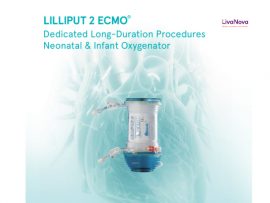Abstract Congenital heart disease (CHD) represents one of the most common congenital malformations, affecting greater than 40,000 births annually in the United States, many of which require surgery during the..
Lee masAbstract Purpose: Cardiopulmonary bypass (CPB) is a nonphysiological procedure in which inflammatory reactions and oxidative stress are induced, hormones and hemodynamic parameters are affected, and circulation is maintained outside the body...
Lee masAbstract Background: The anatomy of major aortopulmonary collateral arteries (MAPCAs) can be highly variable with regard to number, anatomic origin, course, and relationship to the native pulmonary arteries. Some MAPCAs travel..
Lee masAbstract Background Cardiac surgery with cardiopulmonary bypass is associated with systemic inflammation. Ultrafiltration used throughout the cardiopulmonary bypass time, continuously, is hypothesized to be an immunomodulatory therapy. Methods A systematic..
Lee masAbstract The aim of cardiopulmonary bypass is the maintenance of a sufficient whole body perfusion and gas exchange during open or closed heart surgery procedure (coronary artery bypass grafting, valve..
Lee masAbstract Heparin-induced thrombocytopenia (HIT) is an immune-mediated from unfractionated or low-molecular-weight heparin that results in thrombocytopenia and potentially catastrophic thrombosis. HIT occurs due to the development of platelet-activating antibodies against multimolecular..
Lee masAbstract Selective vascular access to the brain is desirable in metabolic tracer, pharmacological and other studies aimed to characterize neural properties in isolation from somatic influences from chest, abdomen or..
Lee masAbstract BACKGROUND: We examined the relationship between blood transfusion and long-term adverse events to evaluate the clinical impact of red blood cell (RBC) transfusion on patients undergoing cardiac valve surgery...
Lee masAbstract BACKGROUND Six billion people lack access to safe, timely and affordable cardiac surgical care [1, 2]. In low- and middle-income countries (LMICs), access to cardiac surgery has been poor due..
Lee masAbstract Introduction Microcirculatory dysfunction after is associated with significant morbidity and worse clinical outcomes. Abnormal can occur from multiple causes, including cytokine-mediated vascular , , and an inadequate balance between and . In response to , produce cellular (CAMs)..
Lee masAbstract Background Cardiopulmonary bypass (CPB) is frequently employed for cardiac surgery, and selecting a suitable priming fluid is a prerequisite for CPB. Currently, the commonly used priming fluids in clinics..
Lee masAbstract Complexity and a certain level of uncertainty are inherent to the clinical scenarios faced by the treating teams, often inundated with exhaustive details. Disease arises from a multitude of..
Lee masCriamos esses 3 dias de evento gratuito para te ajudar a entrar em um centro formador reconhecido pela SBCEC. Prof. Elio Carvalho é Biomédico, Microbiologista e Perfusionista pela Unicamp,..
Lee masAbstract Background Extracorporeal membrane oxygenation (ECMO) is utilized as a rescue therapy in the management of pediatric patients with refractory septic shock. Multiple studies support the use of a central..
Lee masAbstract Objective: Neurologic complications in pediatric patients supported by extracorporeal membrane oxygenation (ECMO) are common and lead to morbidity and mortality; however, few modifiable factors are known. Design: Retrospective study..
Lee masAbstract Introduction: Obesity, defined as a body mass index ≥ 40 kg/m2, was considered a relative contraindication to cannulation for extra-corporeal membrane oxygenation (ECMO) during the coronavirus pandemic. While body habitus can..
Lee masAbstract Decannulation of patients on peripheral veno-arterial extracorporeal membrane oxygenation (VA ECMO) typically involves femoral arterial cutdown and surgical arteriotomy closure in an operating room under general anesthesia. However, this..
Lee masAbstract Background: Veno-arterial extracorporeal membrane oxygenation (VA-ECMO) can re-establish tissue perfusion in refractory cardiac arrest requiring cardiopulmonary resuscitation (CPR). Levosimendan showed potential benefit in VA-ECMO weaning and mortality but was not..
Lee masAbstract Dual circulation is a common but underrecognized physiological occurrence associated with peripheral venoarterial extracorporeal membrane oxygenation (ECMO). Competitive flow will develop between blood ejected from the heart and blood..
Lee masAbstract Purpose Thrombocytopenia (platelet count < 150 × 109/L) is common in intensive care unit (ICU) patients and is likely associated with worse outcomes. In this study we present international contemporary data on thrombocytopenia..
Lee masAbstract Cardiac surgery using cardiopulmonary bypass (CPB) provokes a systemic inflammatory response. This is mainly triggered by contact activation of blood by artificial surfaces of the extracorporeal circuit. Although often..
Lee masAbstract Extracorporeal membrane oxygenation (ECMO) exposes patients to multiple radiologic studies. We hypothesized ECMO patients endure radiation exposure in excess of the International Commission of Radiological Protection (ICRP) recommendations of..
Lee masAbstract During extracorporeal membrane oxygenation (ECMO) blood is exposed to artificial surfaces, resulting in contact activation of the intrinsic coagulation pathway initiated by coagulation factor XII (FXII). Little is known..
Lee masAbstract Purpose Venoarterial extracorporeal membrane oxygenation (V-A ECMO) can be used to support severely ill patients with cardiogenic shock. While age is commonly used in patient selection, little is known..
Lee masAbstract Background: Hospitalized COVID-19 patients with hypoxemic respiratory failure may deteriorate despite invasive mechanical ventilation and thus require extracorporeal membrane oxygenation (ECMO) support. Unfractionated heparin (UFH) is the antithrombotic of..
Lee masAbstract Background In the recent ALBICS (ALBumin In Cardiac Surgery) trial, 4% albumin used for priming and volume replacement increased perioperative bleeding compared with . In the present exploratory study, albumin-related bleeding..
Lee masAbstract The recent study by Scolari et al. [] entitled ‘Association between serum lactate levels and mortality in patients with cardiogenic shock receiving mechanical circulatory support: a multicenter retrospective cohort..
Lee masAbstract Pulmonary arterial pressure (PAH) usually increases after cardiopulmonary bypass (CPB), but this normally does not affect weaning off CPB. Here we report a case of severe PAH in a..
Lee masAbstract Surgical resection of obstructive tracheal tumors can be challenging to cardiothoracic surgeons and anesthesiologists. It is often difficult in these cases to maintain oxygenation by face mask ventilation during..
Lee masAbstract Objective To determine the effect of intensive care unit (ICU) length of stay (LOS) on hospital mortality and non-home discharge for patients undergoing cardiac surgery over a 16-year period..
Lee mas
















